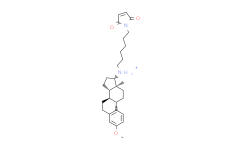| Description: |
U-73122 is an inhibitor of phospholipase C (PLC), phospholipase A2, and 5-LO (5-lipoxygenase). |
| In Vivo: |
U73122 significantly attenuates TNF-α mRNA expression, has no effect on sham animals, but significantly increases heart work and rate of contraction and relaxation without affecting heart rate in endotoxemic mice[4]. U73122 (400 nM/μL) significantly reduces total lordosis durations, compared to vehicle infusions to the VTA, of oestradiol and progesterone-primed hamsters. VTA infusions of U73122 do not alter motor behaviour of hamsters in the activity monitor, but there is a significant effect of muscimol to decrease total number of beam breaks compared to hamsters administered SKF38393[5]. |
| In Vitro: |
U-73122 potently inhibits receptor-coupled activation of PLC in membranes isolated from PMNs[1]. U-73122 inhibits N-formyl-methionyl-leucyl-phenylalanine-induced aggregation of human polymorphonuclear neutrophils (PMN) and the associated production of IP3 and diacyglycerol[2]. U-73122 markedly inhibits inositol phosphate release elicited by either oxotremorine-M or guanosine-5'-O-(3-thiotriphosphate) than that induced by added Ca2+ in digitonin-permeabilized cells[3]. |
| Kinase Assay: |
PMNs (4×107/4 mL) are incubated with U-73122 according to protocols. The reactions are stopped with cold calcium-free PBS. The cells are centrifuged at 750 × g (4°C) and resuspended in 1 mL of Triton X-100-free extraction buffer (50 mM Tris, pH 7.5, 50 mM fimercaptoethanol, 2 mM EGTA, 1 mM phenylmethylsulfonyl fluoride and 4 μg/mL of leupeptin, soybean trypsin inhibitor and aprotinin), and then sonicated for 10- and 5-sec consecutive bursts at 20% output. The lysates are centrifuged at 240 × g (4°C) for 20 mm in a TL-100 ultracentrifuge with the supernatant designated as the cytosol fraction. The pellet is resuspended in 1% Triton-containing extraction buffer, sonicated, shaken for 30 mm at 4°C and centrifuged (240 × g for 20 mm at 4°C). The supernatant constitutes the extractable particulate fraction, and the pellet is sonicated in extraction buffer with Triton and constituted the nonextractable particulate fraction. |
| Cell Assay: |
Agonist-induced production of IP3 in PMN is measured by use of the competitive radiobinding assy. PMN (2 x 106-107) in 0.2 mL of phosphate-buffered saline, pH 7.4 [NaC1 (138 mM), Na2HPO4 (8.1 mM), KH2PO4 (1.5 mM), KCI (2.7 mM), CaCl2 (1.0 mM), MgC12 (1.0 mM) and glucose (0.1%, w/v)] are incubated in conical polypropylene tubes at 37°C in a shaking water bath. U-73122 or U-73343 is added (in 1 μL of DMSO) 3 min before the addition of agonist, FMLP (0.1 μM) plus cytochalasin B (5 μg/mL). FMLP and cytochalasin B are added in 1 μL each of DMSO and ethanol, respectively. Appropriate vehicle controls are included in each experiment. PMN incubation mixtures are quenched with the addition of 0.07 mL of ice-cold TCA (20%, w/v) and a portion (0.2 mL) of the TCA extract is processed for the measurement of IP3 by competitive radiobinding as described above for platelets. |
| Animal Administration: |
Hamsters are hormone-primed with 17β-oestradiol at h 0 and progesterone at h 45. At h 48, hamsters are pretested for motor behaviour, followed by sexual behaviour testing, and bilateral infusions of U73122 (400 nM/μL) or saline vehicle. Thirty minutes after infusions, hamsters are re-tested for sexual behaviour (post inhibitor infusion test) and, immediately after testing, infused bilaterally with SKF38393 (100 ng/μL), muscimol (100 ng/μL), or saline vehicle. Thirty minutes after the agonist or vehicle infusions, lordosis and motor behaviour of hamsters is reassessed (post agonist infusion test). All hamsters are assigned to one pretreatment condition, U73122 or vehicle, and are tested once a week for 3 weeks until all infusion conditions (SKF38393, muscimol or vehicle), are received. The order in which hamsters receive SKF38393, muscimol or vehicle infusions is counterbalanced across the group. |
| References: |
[1]. Smith RJ, et al. Receptor-coupled signal transduction in human polymorphonuclear neutrophils: effects of a novel inhibitor of phospholipase C-dependent processes on cell responsiveness. J Pharmacol Exp Ther. 1990 May;253(2):688-97.
[2]. Bleasdale JE, et al. Selective inhibition of receptor-coupled phospholipase C-dependent processes in human platelets and polymorphonuclear neutrophils. J Pharmacol Exp Ther. 1990 Nov;255(2):756-68.
[3]. Thompson AK, et al. The aminosteroid U-73122 inhibits muscarinic receptor sequestration and phosphoinositide hydrolysis in SK-N-SH neuroblastoma cells. A role for Gp in receptor compartmentation. J Biol Chem. 1991 Dec 15;266(35):23856-62.
[4]. Peng T, et al. Disruption of phospholipase Cgamma1 signalling attenuates cardiac tumor necrosis factor-alpha expression and improves myocardial function during endotoxemia. Cardiovasc Res. 2008 Apr 1;78(1):90-7. Epub 2007 Dec 12.
[5]. Frye CA, et al. In the ventral tegmental area, the membrane-mediated actions of progestins for lordosis of hormone-primed hamsters involve phospholipase C and protein kinase C. J Neuroendocrinol. 2007 Sep;19(9):717-24. |

 To enhance service speed and avoid tariff delays, we've opened a US warehouse. All US orders ship directly from our US facility.
To enhance service speed and avoid tariff delays, we've opened a US warehouse. All US orders ship directly from our US facility.




















